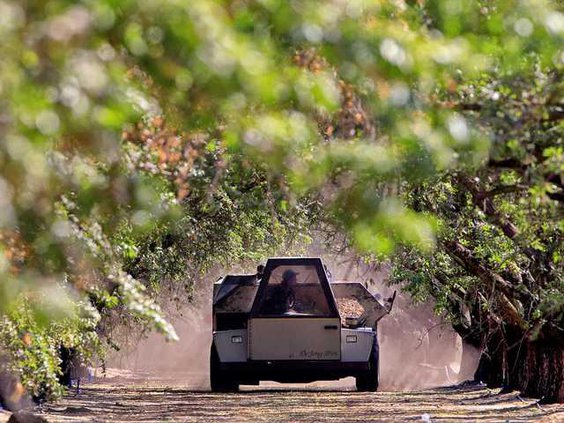The good news for almond farmers who may set a record this year for production in a single year? There’s plenty of water to sustain the seemingly endless supply of bumper crop seasons.
The bad news? That rain fell at the wrong time for many of them in the Northern San Joaquin Valley who are facing the prospect of lower yields thanks to torrential downpours during the bloom period.
While the California almond crop – which supplies 80 percent of the almonds supplied around the world in a given year – is expected to reach 2.2 billion pounds this year, some farmers who are already deep into their harvest are noticing that things aren’t quite as good as they were at the same point last year despite the fact they were into the fourth year of one of the worst droughts in state history with a crop that is heavily dependent on water.
“I’ve been farming my whole life and when it rains during a bloom you don’t ever get a good crop,” said Ripon farmer Dave Phippen, a partner in the company Travaille and Phippen that grows, packs and ships the crop to all corners of the world. “To put it into perspective, 1983 is the only year that I’ve ever (needed) crop insurance because we had such extensive rains during the bloom period, and I think that we just went through this winter was worse than what we saw in 1983.
“I wasn’t expecting to have a great year this year but I thought that if I could just get a yield like I did last year I would be very happy – it looks like that’s not going to happen right now.”
Despite facing a dire water situation that worsened each of the last four years, the California almond harvest has continued to grow steadily since 2014 when crop yields were below 1.9 billion pounds.
Part of that continuing increase year-after-year, Phippen said, can be attributed to the growing number of orchards that are being farmed in the state, something that he believes will be responsible for reaching record numbers this year despite the fact that farmers in Northern California aren’t seeing the same results as they did in 2016. The other half of the equation, he said, is that farmers in the southern part of the valley are reporting better results than last year, adding to the overall totals.
“We’ve all seen the forecasts that this is going to be a record crop, and I believe that’s because we have more acres in production this year and not because the crop is necessarily going to be big,” Phippen said. “I think that we need to temper those expectations a bit now that we have something like a million producing acres here in California.”
While the United States Department of Agriculture’s crop forecast for almonds released back in May predicted that an extended bloom period may have offset the heavy rains both before and during the bloom period – which makes application of sprays intended to protect the blooms more difficult – and called for a 2.8 percent overall increase in the total crop yield, Phippen said that some of the farmers that he has talked to have also shared that they’ve seen results to similar to his and that the rain put a dent in things this season.
Even though seeing reservoirs recharged in a single winter was welcome news for growers throughout the state, Phippen said that timing was everything.
“We were all praying for rain and we got it,” he said. “It would have just been nice if it didn’t rain during bloom.”
To contact reporter Jason Campbell email jcampbell@mantecabulletin.com or call 209.249.3544.
Spring rains dampen almond harvest



